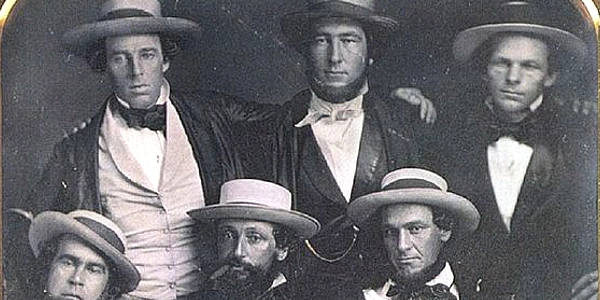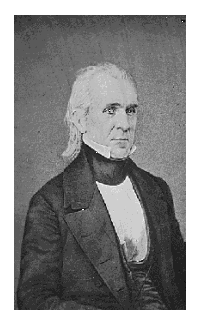Sponsor this page. Your banner or text ad can fill the space above.
Click here to Sponsor the page and how to reserve your ad.
-
Timeline
1845 - Detail
October 21, 1845 - The New York Herald becomes the first newspaper to mention the game of baseball. In this year, Alexander Cartwright and his New York Knickerbockers baseball team codify the "rules of baseball" for the first time, including nine men per side.

The New York Herald covered a game that many associated with rounders, but had been played by various local clubs, including Alexander Cartwright's New York Knickerbockers, under a variety of rules. On this day, the Herald noticed that a game was upcoming on the next, to be played at Elysian Fields in Hoboken, New Jersey, on October 22, 1845. The rules of the game had been codified, at least the Knickerbocker version, not even a month before, on September 23, and printed in a pamphlet in Cooperstown, New York. Yes, that's baseball's Hall of Fame town.
The Herald had been promoting this new sport for several weeks before, however, announcing an upcoming game for October 7 that they didn't think, for some reason would happen. "Sporting Events: A Base Ball match between eight players of Brooklyn and eight players of New York, was announced to take place in Brooklyn to-day, and also a shooting match of the Anglo-American Club of this city. It is not believed, however, that either of these events will "come off" in consequence of some mal-arrangement or misunderstanding among the several parties."
The next day, the New York Herald stated that the game did not occur, under an odd heading. "A True Prophecy - We stated yesterday that the proposed baseball match between eight players of New York and eight players of Brooklyn, would turn out to be a failure; and so it was, for the New Yorkers did not make their appearance on the ground, and the supper provided by their order was unnecessarily untouched."
So there does seem to be some misundertanding about these first reported games, and their exact dates. Two weeks later, the New York Herald announced another upcoming game ... "The New York Baseball Club will play a match of baseball against the Brooklyn Club, tomorrow afternoon, at 2 o'clock, at the Elysian Fields, Hoboken." We do not know whether this actually occurred; the October 22nd edition does not seem to include an outcome.
So you can choose which date you think more appropriate as the first mention; it seems October 6 may have the nod. October 21 may have been the first mention of a game that actually occurred, but we don't know that for certain either. In either case, games during this era were very high scoring affairs, with some old boxscores showing a 41 to 34 tally.
By 1848, the Knickerbocker club had introduced fines for bad behavior. Twelve and one half cents every time you swore or argued with an umpire. Fifty cents if you went against the orders of your team captain. Fines had to be paid before you left the field.

Early Base Ball Controversy
For many the biggest controversies about pre-MLB baseball, which would begin in National Association League in 1871, was not about what date it was first reported, but more about who made the rules and truly invented the game. Although Abner Doubleday, a general in the Civil War, was granted that designation by the Mills Commission in its December 30, 1907 report, it was not accurate. Doubleday may have improved on the game and introduced it to students in Cooperstown in 1839 as noted in the report, and provisioned bats and balls while in Army command, but he was not its inventor. He never claimed that he was during his lifetime.
Alexander Cartwright is noted by some as the rightful next heir to that claim, although his contribution with the New York Knickerbocker Base Ball Club from 1842-1848 is more as a pioneer of the sport. By 1849, Cartwright was chasing gold in California and spend the rest of his life in Hawaii. The Gotham Baseball Club predated the New York Knicks, beginning in 1837, with William Wheaton devising the rules for that club. There were other variants of the rules during that era, now known as the Massachusetts Game, which began in 1858 and used a sixty foot distance for the bases, and the Philadelphia Game, or Philadelphia Town Ball, which some contend was being played in 1831 and 1832, with their Olympic Ball Club formalizing its constitution in 1833.
Rules and Regulations of the Recently Invented Game of Baseball, September 23, 1845
Rules and Regulations of the Recently Invented Game of Base Ball, As Adopted By the Knickerbocker Base Ball Club on September 23, 1845. Printed in Cooperstown, New York.
For many years the games of Town ball, Rounders and old Cat have been the sport of young boys. Recently, they have, in one form or another, been much enjoyed by gentlemen seeking wholesome American exercise. In 1845, Alexander Cartwright and other members of the Knickerbocker Base Ball Club of New York codified the unwritten rules of these boys games into one, and so made the game of Base Ball a sport worthy of attention by adults. We have little doubt but that this gentlemanly pastime will capture the interest and imagination of sportsman and spectator alike throughout the country.
Herewith are offered the first and complete rules of the game of Base Ball as played by the Knickerbocker Base Ball Club:
Rules and Regulations
1st. Member must strictly observe the time agreed upon for exercise, and be punctual in their attendance.
2nd. When assembled for exercise, the President, or in his absence the Vice-President, shall appoint an Umpire, who shall keep the game in a book provided for that purpose, and note all violations of the By-Laws and Rules during the time of exercise.
3rd. The presiding officer shall designate two members as Captains, who shall retire and make the match to be played, observing at the same time that the players put opposite to each other should be as nearly equal as possible; the choice of sides to be then tossed for and the first in hand to be decided in like manner.
4th. The bases shall be from "home" to second base, forty-two paces; from first to third base, forty-two paces, equidistant.
5th. No stump match shall be played on a regular day of exercise.
6th. If there should not be a sufficient number of members of the Club present at the time agreed upon to commence exercise, gentlemen not members may be chosen in to make up the match, which shall not be broken up to take in members that may afterward appear; but, in all cases, members shall have the preference, when present, at the making of a match.
7th. If members appear after the game is commenced they may be chosen in if mutually agreed upon.
8th. The game to consist of twenty-one counts, or aces; but at the conclusion an equal number of hands must be played.
9th. The ball must be pitched, and not thrown, for the bat.
10th. A ball knocked out the field, or outside the range of the first or third base, is foul.
11th. Three balls being struck at and missed and the last one caught, is a hand out; if not caught is considered fair, and the striker bound to run.
12th. If a ball be struck, or tipped, and caught, either flying or on the first bound, it is a hand out.
13th. A player running the bases shall be out, if the ball is in the hands of an adversary on the base, or the runner is touched with it before he makes base; it being understood, however, that in no instance is a ball to be thrown at him.
14th. A player running who shall prevent an adversary from catching or getting the ball before making his base, is a hand out.
15th. Three hand out, all out.
16th. Players must take their strike in regular turn.
17th. All disputes and differences relative to the game, to be decided by the Umpire, from which there is no appeal.
18th. No ace or base can be made on a foul strike.
19th. A runner can not be put out in making one base, when a balk is made by the pitcher.
20th. But one base allowed when a ball bounds out of the field when struck.
Photo above: New York Knickerbockers Ball Club in 1847, Alexander Cartwright in the top center, William Wheaton, top left, 1847, Unknown. Courtesy Wikipedia Commons. Image Below: Elysian Fields, Hoboken, New Jersey, 1859, Harper's Weekly. Courtesy Library of Congress. Information Source: Awesomestories.com; Baseball Hall of Fame;
"Evolution or Revolution? A Rule-By-Rule Analysis of the 1845 Knickerbocker Rules," Jeff Kittel; Wikipedia Commons.





